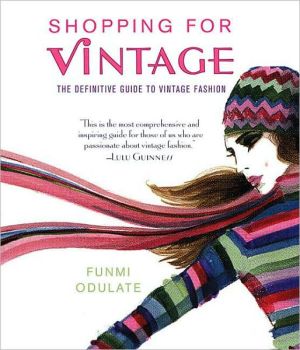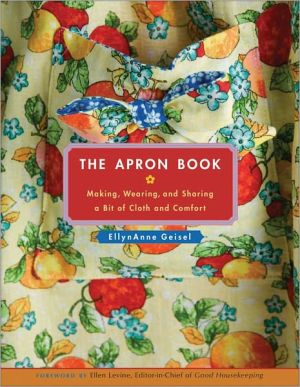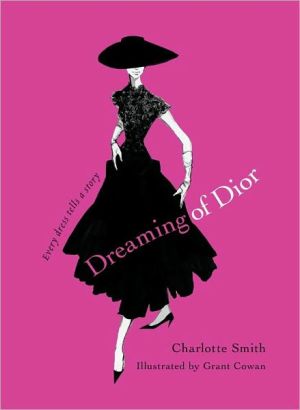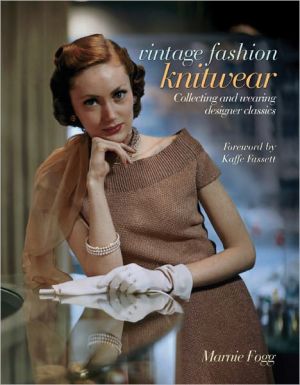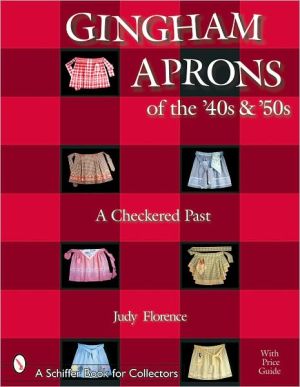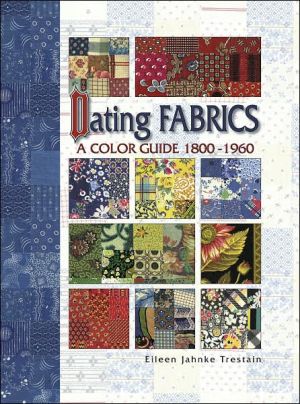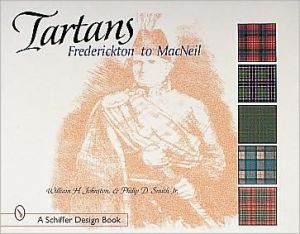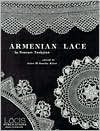Shopping for Vintage: The Definitive Guide to Vintage Fashion
This definitive guide to vintage clothing and accessories covers every major fashion epoch and designer from the 1880s to today—from Charles Worth to Vivienne Westwood. With snapshots of the key designers to the pivotal pieces that defined each decade, fashion expert Funmi Odulate takes you through the history of each era.\ Included is an extensive country-by-country directory of vintage shops, fairs, and flea markets, with profiles of the major dealers and outstanding shops, from L.A. to...
Search in google:
This definitive guide to vintage clothing and accessories covers every major fashion epoch and designer from the 1880s to today—from Charles Worth to Vivienne Westwood. With snapshots of the key designers to the pivotal pieces that defined each decade, fashion expert Funmi Odulate takes you through the history of each era.Included is an extensive country-by-country directory of vintage shops, fairs, and flea markets, with profiles of the major dealers and outstanding shops, from L.A. to Shanghai.Packed with insider tips about what to look for when buying vintage, how to recognize something of value and most importantly, where to find it, this is a stunning and sophisticated reference for all lovers of vintage fashion.
Shopping For Vintage\ Designers and their DECADESLA belle Époque 1890-1914The French phrase "La Belle Époque" refers to the pre-war "fine period" typified by extravagant dressing and the height of luxury living for the elite. The bustle disappeared from dresses, and Charles Worth's "Princess line"—a more pared-down, sophisticated version of the A-line shape—developed into the new style of skirt. Ultra-voluminous dress sleeves, known as "Leg of Mutton" sleeves, became the . When these were used on evening dresses, a tiny waist and huge skirt highlighted the proportions even further. These full sleeves made it impossible to wear coats, so cloaks, as an alternative form of outerwear, became very popular. An especially fashionable version was the pelerine, a short cape that was slightly longer at the front. The S-bend "health" corset set the tone for fashionable women right up until 1905. It was known as such because as the corset was tightly laced up, it forced the hips back and pushed the bosom forward, creating an almost pigeonlike S-shape and a "monobosom." Tailor-made suits-first introduced in Britain by Redfern and the house of Creed—were worn with high-necked white shirts and a bustled skirt or occasionally bloomers. Although in 1880 such outfits were initially viewed as masculine and unladylike, by 1900 they were firmly established. After 1907, the empire line and longer-line corset—almost knee-length—had become fashionable; it made women look much slimmer. Known as the "Directoire" style, this look was pioneered by Paul Poiret.charles WORTHWho? Charles Frederick Worth was an English dressmaker who found fame in Paris and became known as "The Father of Modern Haute Couture."Style and design? Opulent and incredibly expensive gowns, many of which were redolent of earlier centuries. Worth was also recognized for having introduced the crinoline in the mid-1800s. This cone-shaped contraption, made up of cloth and metal, was used to support expansive petticoats/skirts and became the fashionable mode of dress, mainly through the patronage of Empress Eugénie. (Worth has been credited with pioneering "fashion promotion." By dressing high-profile figures in his conspicuous gowns, he successfully garnered publicity for both himself and the client.)Jeanne PAQUINWho? When Madame Jeanne Paquin set up her Parisian maison de couture in 1891, it was the first fashion house to be run by a woman. Style and design? Pioneered the use of fur as a trim or accessory. Introduced the empire-line evening dress and was regarded as the "master" of coats.madeleine CHERUITWho? Designer Madeleine Cheruit was trained in the 1880s at the couture house of Raudnitz, in Paris.Style and design? Bridged the gap between couture and ready-to-wear. Her richly ornamented dresses were a lush combination of taffeta, gauze, lamé, and sequins and were favored by aristocratic clients. At the beginning of the Twenties, however, her lavish style lost its appeal, when Coco Chanel introduced simple, chic, and pared-down fashion. Although Cheruit retired in 1923, her design house carried on until 1935, when Elsa Schiaparelli notoriously took over her premises.CREEDWho? The House of Creed stemmed from a long line of English tailors (founded 1760) whose designs became highly sought after in nineteenth-century France.Style and design? Understated tweeds, classical English tailoring, and refined ladies suits, which took their inspiration from the masculine style of World War II.jacques DOUCETWho? Designer Monsieur Jacques, as his society clientele used to call him, was a patron of the fine arts. Along with Paul Poiret, who worked for him for a few years, Doucet helped to revive the art of fashion illustration in France, defining the role of the artist within fashion.Style and design? His opulent femininity epitomized the height of the Belle Epoque. His use of pastel colors, flimsy and translucent fabrics, ornate gossamer gowns, bodices of thin ivory chamois, opera capes lined with chinchilla, and high-waisted style, which was de rigueur before World War I, are all well documented.REDFERNWho? Redfern was one of the most successful English tailoring houses. It was the first to offer British ladies tailored suits that were directly influenced by those of their male counterparts.Style and design? Yachting, traveling, and riding suits. Created an outfit for Lillie Langtry, a mistress of the Prince of Wales, who subsequently became King Edward VII. Popularized the high-waisted Grecian style in 1908.CALLOT sœursWho? A design collaboration made up of four sisters—Marie, Marthe, Regina, and Joséphine. The Callot sisters were known as "the backbone of the European fashion world." Madeleine Vionnet, who early in her career worked for the house as a seamstress, heaped further praise on the quartet by famously saying "Without the example of Callot Soeurs, I would have continued to make Fords. It is because of them that I have been able to make Rolls-Royces."Style and design? Used beautiful but unusual materials, such as antique lace, rubberized gabardine and Asian silks—Orientalism was characteristic of their work. Callot Soeurs placed metallic gold and silver lamé dresses at the forefront of fashion during the 1910s and Twenties. One of the notable houses of the Belle Epoque.paul POIRETWho? The "Sultan of Fashion", Paul Poiret, was the couturier who turned the convention of fashion on its head, irrevocably changing the way women dress. A significant advocate of art moderne (later known as Art Deco).Style and design? In 1909 he introduced a fluid style of dress known as "Directoire," because of their resemblance to styles worn during the Directory government in France (1795-99). Skirts fell straight from the waist to within two inches of the ground, and waists rose to just under the bust. These encouraged women to abandon their S-bend corsets in favor of high-fitting boned belts. He used bright colors at a time when the "sweet pea" Edwardian colors were still very much in vogue. Inspired by the costumes of Léon Bakst for Diaghilev's Ballets Russes in 1913, he also produced a collection of exotic designs, which included oriental harem pants, lampshade tunics, and turbans—all brightly colored and fully embellished. Poiret was famous for making trousers for women—seen as a type of liberation—and also, ironically went on to make clothes that restricted their movements. The Hobble Skirt was so named because the narrowness of the skirt created a "hobble effect" as women walked. A fetter—a type of bondage belt around the ankles so that only slight movements could be made—was worn in addition to the skirt in order to intensify the hobble effect.mariano FORTUNYWho? Spanish-born Mariano Fortuny y Madrazo initially worked as a painter before going into fashion.Style and design? In 1907 a nostalgia for Classical Greece surfaced in fashion, art, and theatre. It was during this time that Fortuny created his famous "Delphos" dress. This was the name he gave to his long, clinging sheath dresses constructed from four to five widths of silk that were sewn into a tubular shape and secured at the shoulders. These dresses, popular with actresses and dancers, such as Isadora Duncan, undulated with color, having been repeatedly immersed in varying shades of dye. The principle of this dress has resurfaced in more modern forms—such as the Eighties' "Please Pleats" collection by Issey Miyake.Text copyright © 2006 by Funmi Odulate.
